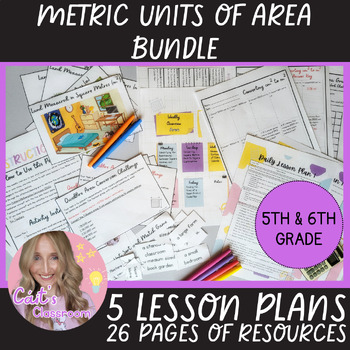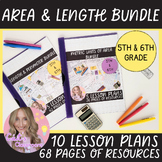Area and Surface Area│5-Day-Unit│Hands-on Math Lesson Plans and Area Worksheets
- Zip
Products in this Bundle (5)
Bonus
Also included in
- 10 lesson plans & 68 pages of activities/resources on area, perimeter and length for fifth and sixth class.Revolutionize your math classes with this comprehensive resource covering topics such as:Measuring, calculating, and converting square metres to square centimetres.Calculating, converting,Price $26.40Original Price $40.53Save $14.13
Description
5 Lesson Plans & 26 pages of activities/resources on measuring, calculating and converting area/surface area in metric units for fifth and sixth.
Revolutionize your maths classes with this comprehensive resource covering topics such as:
- Measuring, calculating, and converting square metres to square centimetres.
- Calculating, converting, and problem-solving with square metres and centimetres.
- Calculating and converting between square metres, ares, and hectares.
- Identifying the dimensions and calculating the surface area of cubes and cuboids (rectangular prisms).
- Finding the area of a room from a scale drawing.
Includes two BONUS resources: a weekly overview and weekly planning grid
aligned with the new Primary Mathematics Curriculum (2023) for seamless planning and preparation!
Say goodbye to prep stress and hello to maths mastery – grab your copy NOW!
Benefits:
- Saves valuable preparation and planning time by streamlining your planning process.
- Offers a print-and-go, low prep format for convenience with step-by-step instructions.
- Ideal for newly qualified teachers who want support teaching maths to the older grades.
- Enhances student understanding in an engaging, hands-on way.
- Fosters teamwork skills through group challenges and activities.
- Simplifies learning, making it engaging and accessible for your students.
- Enhances mathematical proficiency through increasing conceptual understanding and procedural fluency.
What's Included?
Lesson 1: Area: Measuring, Calculating and Converting Square Centimetres to Metres
This 45-minute lesson plan includes:
- 2 printable templates for the Area Relay Challenge.
- Step by Step instructions on converting cm2 to m2.
- 1 worksheet and answer key on converting cm2 to m2.
- 3 learning objectives.
- Differentiation strategies for both struggling and advanced students.
- Formative and summative assessment ideas.
- Key vocabulary and definitions.
- Explicit links to the new Primary Mathematics Curriculum (2023), specifically the element of understanding and connecting and the competencies of being mathematical, being an active learner and being an effective communicator.
- Explicit links to CCSSM.
Lesson 2: Calculating, Converting and Problem Solving Square Metres & Centimetres
This 45-minute lesson plan includes:
- 1 Quickfire Area Conversion challenge card and answer key.
- 1 group work challenge and answer key.
- Step by Step instructions on converting m2 to cm2.
- 1 worksheet and answer key on converting m2 to cm2.
- 3 learning objectives.
- Differentiation strategies for both struggling and advanced students.
- Formative and summative assessment ideas.
- Key vocabulary and definitions.
- Explicit links to the new Primary Mathematics Curriculum (2023), specifically the element of applying and problem solving and the competencies of being mathematical, being an active learner and being an effective communicator.
- Explicit links to CCSSM.
Lesson 3: Area: Calculating and Converting between Square Metres, Ares and Hectares
This 45-minute lesson plan includes:
- 1 Area Unit Sort and Match game and answer key.
- 6 visuals.
- 1 worksheet and answer key on converting between units of area measurement.
- 3 learning objectives.
- Differentiation strategies for both struggling and advanced students.
- Formative and summative assessment ideas.
- Key vocabulary and definitions.
- Explicit links to the new Primary Mathematics Curriculum (2023), specifically the element of applying and problem solving and the competencies of being mathematical, being an active learner and being an effective communicator.
- Explicit links to CCSSM.
Lesson 4: Surface Area of Cubes and Cuboids (Rectangular Prisms)
This 45-minute lesson plan includes:
- 3D shape guessing game instructions.
- Step by Step instructions on calculating the surface area of cubes and cuboids.
- 1 worksheet and answer key on calculating surface area.
- 3 learning objectives.
- Differentiation strategies for both struggling and advanced students.
- Formative and summative assessment ideas.
- Key vocabulary and definitions.
- Explicit links to the new Primary Mathematics Curriculum (2023), specifically the element of reasoning and the competencies of being mathematical, being an active learner and being an effective communicator.
- Explicit links to CCSSM.
Lesson 5: Metric System: Finding the Area of a Room from a Scale Plan
This 40-minute lesson plan includes:
- 2 scale scavenger hunt worksheets (colour and black & white) and answer key.
- 2 individual practice worksheets (colour and black & white) and answer key.
- 1 calculations rough worksheet.
- 3 learning objectives.
- Differentiation strategies for both struggling and advanced students.
- Formative and summative assessment ideas.
- Key vocabulary and definitions.
- Explicit links to the new Primary Mathematics Curriculum (2023), specifically the element of communicating and the competencies of being mathematical, being an active learner and being well.
- Explicit links to CCSSM.
Elevate your teaching experience and engage your students - secure your complete lesson plan and resources TODAY!
Click here to join the Cáit's Classroom mailing list for valuable tips, tricks, and special offers designed to support newly qualified teachers in effectively teaching maths to 3rd-6th grade students.






